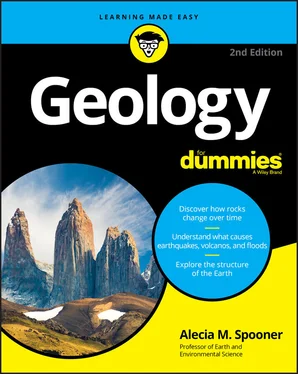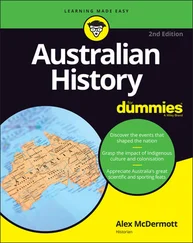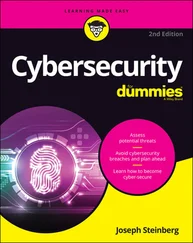Alecia M. Spooner - Geology For Dummies
Здесь есть возможность читать онлайн «Alecia M. Spooner - Geology For Dummies» — ознакомительный отрывок электронной книги совершенно бесплатно, а после прочтения отрывка купить полную версию. В некоторых случаях можно слушать аудио, скачать через торрент в формате fb2 и присутствует краткое содержание. Жанр: unrecognised, на английском языке. Описание произведения, (предисловие) а так же отзывы посетителей доступны на портале библиотеки ЛибКат.
- Название:Geology For Dummies
- Автор:
- Жанр:
- Год:неизвестен
- ISBN:нет данных
- Рейтинг книги:5 / 5. Голосов: 1
-
Избранное:Добавить в избранное
- Отзывы:
-
Ваша оценка:
- 100
- 1
- 2
- 3
- 4
- 5
Geology For Dummies: краткое содержание, описание и аннотация
Предлагаем к чтению аннотацию, описание, краткое содержание или предисловие (зависит от того, что написал сам автор книги «Geology For Dummies»). Если вы не нашли необходимую информацию о книге — напишите в комментариях, мы постараемся отыскать её.
Rock records and geologic time Large-scale motion of tectonic plates Matter, minerals, and rocks The geological processes on earth's surface Rock that geology class with
!
Geology For Dummies — читать онлайн ознакомительный отрывок
Ниже представлен текст книги, разбитый по страницам. Система сохранения места последней прочитанной страницы, позволяет с удобством читать онлайн бесплатно книгу «Geology For Dummies», без необходимости каждый раз заново искать на чём Вы остановились. Поставьте закладку, и сможете в любой момент перейти на страницу, на которой закончили чтение.
Интервал:
Закладка:
4 Part 2: Elements, Minerals, and Rocks Chapter 5: It’s Elemental, My Dear: A Very Basic Chemistry of Elements and Compounds The Smallest Matter: Atoms and Atomic Structure Chemically Bonding Formulating Compounds Chapter 6: Minerals: The Building Blocks of Rocks Meeting Mineral Requirements Making Crystals Identifying Minerals Using Physical Characteristics Realizing Most Rocks Are Built from Silicate Minerals Remembering the Nonsilicate Minerals Gemstones Chapter 7: Recognizing Rocks: Igneous, Sedimentary, and Metamorphic Types Mama Magma: Birthing Igneous Rocks Merging Many Single Grains of Sand: Sedimentary Rocks Stuck between a Rock and a Hard Place: Metamorphic Rocks Tumbling through the Rock Cycle: How Rocks Change from One Type to Another
5 Part 3: One Theory to Explain It All: Plate Tectonics Chapter 8: Adding Up the Evidence for Plate Tectonics Drifting Apart: Wegener’s Idea of Continental Drift Coming Together: How Technology Sheds Light on Plate Tectonics Chapter 9: When Crustal Plates Meet, It’s All Relative Density Is Key Two of a Kind: Continental and Oceanic Crust Understanding Why Density Matters: Isostasy Defining Plate Boundaries by Their Relative Motion Shaping Topography with Plate Movements Chapter 10: Who’s Driving This Thing? Mantle Convection and Plate Movement Running in Circles: Models of Mantle Convection Using Convection to Explain Magma, Volcanoes, and Underwater Mountains Shake, Rattle, and Roll: How Plate Movements Cause Earthquakes
6 Part 4: Superficially Speaking: About Surface Processes Chapter 11: Gravity Takes Its Toll: Mass Wasting Holding Steady or Falling Down: Friction versus Gravity Focusing on the Materials Involved Triggering Mass Movements Moving Massive Amounts of Earth, Quickly A More Subtle Approach: Creep and Soil Flow (Solifluction) Chapter 12: Water: Above and Below Ground Hydrologic Cycling Streams: Moving Sediments toward the Ocean Eroding a Stream Channel to Base Level Seeking Equilibrium after Changes in Base Level Leaving Their Mark: How Streams Create Landforms Flowing beneath Your Feet: Groundwater Chapter 13: Flowing Slowly toward the Sea: Glaciers Identifying Three Types of Glaciers Understanding Ice as a Geologic Force Eroding at a Snail’s Pace: Landforms Created by Glacial Erosion Leaving It All Behind: Glacial Deposits Where Have All the Glaciers Gone? Chapter 14: Blowing in the Wind: Moving Sediments without Water Lacking Water: Arid Regions of the Earth Transporting Particles by Air Deflating and Abrading: Features of Wind Erosion Just Add Wind: Dunes and Other Depositional Wind Features Paving the Desert: Deposition or Erosion? Chapter 15: Catch a Wave: The Evolution of Shorelines Breaking Free: Waves and Wave Motion Shaping Shorelines Categorizing Coastlines
7 Part 5: Long, Long Ago in This Galaxy Right Here Chapter 16: Getting a Grip on Geologic Time The Layer Cake of Time: Stratigraphy and Relative Dating Show Me the Numbers: Methods of Absolute Dating Relatively Absolute: Combining Methods for the Best Results Eons, Eras, and Epochs (Oh My!): Structuring the Geologic Timescale Chapter 17: A Record of Life in the Rocks Explaining Change, Not Origins: The Theory of Evolution The Evolution of a Theory Putting Evolution to the Test Against All Odds: The Fossilization of Lifeforms Correcting for Bias in the Fossil Record Hypothesizing Relationships: Cladistics Chapter 18: Time before Time Began: The Precambrian In the Beginning … Earth’s Creation from a Nebulous Cloud Addressing Archean Rocks Originating with Orogens: Supercontinents of the Proterozoic Eon Single Cells, Algal Mats, and the Early Atmosphere Questioning the Earliest Complex Life: The Ediacaran Fauna Chapter 19: Teeming with Life: The Paleozoic Era Exploding with Life: The Cambrian Period Building Reefs All Over the Place Spinal Tapping: Animals with Backbones Planting Roots: Early Plant Evolution Tracking the Geologic Events of the Paleozoic Chapter 20: Mesozoic World: When Dinosaurs Dominated Driving Pangaea Apart at the Seams Repopulating the Seas after Extinction The Symbiosis of Flowers Recognizing All the Mesozoic Reptiles Climbing the Dinosaur Family Tree Flocking Together: The Evolutionary Road to Birds Laying the Groundwork for Later Dominance: Early Mammal Evolution Chapter 21: The Cenozoic Era: Mammals Take Over Putting Continents in Their Proper (Okay, Current) Places Entering the Age of Mammals Living Large: Massive Mammals Then and Now Right Here, Right Now: The Reign of Homo Sapiens Arguing for the Anthropocene Chapter 22: And Then There Were None: Major Extinction Events in Earth’s History Explaining Extinctions End Times, at Least Five Times Modern Extinctions and Biodiversity
8 Part 6: The Part of Tens Chapter 23: Ten Ways You Use Geologic Resources Every Day Burning Fossil Fuels Playing with Plastics Gathering Gemstones Drinking Water Creating Concrete Paving Roads Accessing Geothermal Heat Fertilizing with Phosphate Constructing Computers Building with Beautiful Stone Chapter 24: Ten Geologic Hazards Changing Course: River Flooding Caving In: Sinkholes Sliding Down: Landslides Shaking Things Up: Earthquakes Washing Away Coastal Towns: Tsunamis Destroying Farmland and Coastal Bluffs: Erosion Fiery Explosions of Molten Rock: Volcanic Eruptions Melting Ice with Fire: Jokulhlaups Flowing Rivers of Mud: Lahars Watching the Poles: Geomagnetism
9 Index
10 About the Author
11 Supplemental Images
12 Advertisement Page
13 Connect with Dummies
14 End User License Agreement
List of Tables
1 Chapter 5 TABLE 5-1 Common Elements in Earth’s Crust
2 Chapter 6 TABLE 6-1 Silicate Mineral GroupsTABLE 6-2 Common Carbonate MineralsTABLE 6-3 Sulfide and Sulfate MineralsTABLE 6-4 Common Oxide MineralsTABLE 6-5 Common Native Element Minerals
3 Chapter 7TABLE 7-1 Classification of Igneous RocksTABLE 7-2 Detrital Sedimentary RocksTABLE 7-3 Chemical Sedimentary RocksTABLE 7-4 Metamorphic Rocks
4 Chapter 9TABLE 9-1 Characteristics of Oceanic and Continental Crust
5 Chapter 11TABLE 11-1 Types of Mass Wasting
6 Chapter 16TABLE 16-1 Commonly Used Radioactive Isotopes for Dating
7 Chapter 18TABLE 18-1 Comparing Banded Iron Formations (BIFs) and Continental Red Beds (CRB...
8 Chapter 19TABLE 19-1 Major Developments in Paleozoic Plant Evolution
List of Illustrations
1 Chapter 2FIGURE 2-1: a) Pie graph; b) Bar graph; c) Line graph; d) Scatterplot.
2 Chapter 3FIGURE 3-1: In this sketch of rock layers, the oldest is A, and the youngest is...
3 Chapter 4FIGURE 4-1: The five major spheres of Earth’s planetary system.FIGURE 4-2: The path of wave travel if Earth’s interior were a continuous solid...FIGURE 4-3: The recorded path of P waves and S waves.FIGURE 4-4: The layers of the earth.
4 Chapter 5FIGURE 5-1: The parts of an atom.FIGURE 5-2: The parts of one square of the periodic table of elements.FIGURE 5-3: The periodic table of the elements.FIGURE 5-4: The ionic bond between sodium and chloride to form a molecule of Na...FIGURE 5-5: Covalent bonding in a water molecule.FIGURE 5-6: Metallic bonding between atoms in a sea of electrons.
5 Chapter 6FIGURE 6-1: Mohs relative mineral hardness scale.FIGURE 6-2: Cleavage planes of muscovite, feldspar, halite, and flourite.FIGURE 6-3: The appearance of a conchoidal mineral fracture.FIGURE 6-4: The silicon-oxygen tetrahedron.FIGURE 6-5: The single chain silicate structure.FIGURE 6-6: The double chain silicate structure.FIGURE 6-7: The sheet silicate structure.FIGURE 6-8: The framework silicate structure.FIGURE 6-9: The ring silicate structure.
6 Chapter 7FIGURE 7-1: Bowen’s reaction series.FIGURE 7-2: Features of a volcano.FIGURE 7-3: Features of a shield volcano.FIGURE 7-4: Features of a stratovolcano or composite cone.FIGURE 7-5: Features of a cinder cone volcano.FIGURE 7-6: Types of intrusive igneous features.FIGURE 7-7: Mechanical weathering of a rock into sediment.FIGURE 7-8: Weathering by exfoliation.FIGURE 7-9: Poorly sorted and well-sorted sediments.FIGURE 7-10: Cross-bedding.FIGURE 7-11: Graded bedding.FIGURE 7-12: Current ripple marks.FIGURE 7-13: Mud cracks.FIGURE 7-14: Contact metamorphism.FIGURE 7-15: Index minerals in shale metamorphism.FIGURE 7-16: Indirect and direct pressure.FIGURE 7-17: The foliation of minerals by direct pressure.FIGURE 7-18: The rock cycle.
Читать дальшеИнтервал:
Закладка:
Похожие книги на «Geology For Dummies»
Представляем Вашему вниманию похожие книги на «Geology For Dummies» списком для выбора. Мы отобрали схожую по названию и смыслу литературу в надежде предоставить читателям больше вариантов отыскать новые, интересные, ещё непрочитанные произведения.
Обсуждение, отзывы о книге «Geology For Dummies» и просто собственные мнения читателей. Оставьте ваши комментарии, напишите, что Вы думаете о произведении, его смысле или главных героях. Укажите что конкретно понравилось, а что нет, и почему Вы так считаете.












